NEST Gimbal and "L" plate
Aug 7, 2019 11:25:38 #
Aug 7, 2019 12:16:53 #
amfoto1
Loc: San Jose, Calif. USA
There's no case I can think of where ANY L-plate would be used with ANY gimbal head.
Gimbals are designed to be used with large lenses that have their own tripod mounting collars.
L-plates are designed to be used on camera bodies fitted with shorter lenses, to allow the camera to be directly mounted to the quick release platform of the tripod head and oriented either horiz. or vert.
The two items are not intended to be used together.
L-plates can be used with many different types of heads (other than gimbals), but might be most often used with ballheads, because on those... without an L-plate... vertical orientation means "flopping" the camera and lens off to the side, which makes it somewhat unbalanced.
I forget which, but either Wimberley or Kirk Photo has an accessory to allow a camera to be mounted to a gimbal while not using a big lens with a tripod collar, via a standard Arca-style camera plate. I suppose using that would allow a camera with an L-plate to be mounted too. But it seems to be it would be a lot simpler, when wanting to use the camera with an L-plate, to remove the gimbal from the tripod and replace it with a ballhead. Depending upon the tripod setup, that might require tools to do.
These are some of the reasons I instead use a Wimberley Sidekick gimbal adapter of a full-size gimbal head. The Sidekick fits into the QR platform of a ballhead, which remains on the tripod. So I don't need to carry and swap out heads. I just install or remove the gimbal adapter, depending upon whether or not I'm using a large lens with a tripod mounting collar.
I'm not a fan of L-brackets in general... they add a lot of bulk to the camera and are expensive. So I was pleased to discover another use for the Sidekick. Because it's a "side mount" design (unlike many other gimbals that are "bottom mount"), the Sidekick also comes in handy to set up a camera and short lens combo in vertical orientation. I've often used it that way.
Side mount gimbals, like the Sidekick, only have one axis of movement (tilt) and aren't rated for quite as much weight as full size, bottom mount gimbals can handle. (The ballhead it's used with provides the panning axis.... a heavy duty ballhead is recommended for use with gimbal adapters. I use a Kirk BH-1 rated for around 50 lb.)
The Sidekick is rated to handle up to about an 8 lb. lens with a typical DSLR, which weigh up to around 2 lb. I've used it extensively without any problem with 500mm f/4, and sometimes loaded up with teleconverter, flash bracket, flash and more. But I've seen people using them without any problem with up to 400mm f/2.8 and 600mm f/4 lenses.
Two other adapters I am aware of are the Induro GHBA (similar to Sidekick) and the Jobu BWG "Mini" (lower priced, smaller and rated for about half the weight of the Sidekick or Induro).
All the above gimbals and ballheads... every L-bracket I'm aware of... as well as many other tripod heads and other accessories utilize and are compatible with the Arca-Swiss Quick Release system. Many different manufacturers make products and accessories based upon that system. There are even now some cameras (Fujifilm) and lenses (Tamron) that have incorporated dovetails into some of their designs.
Personally I don't have the Nest gimbal (yet!). It seems top quality and an excellent value. I'm not knocking it, by any means. In fact I've often recommended it and I do have a similar full size gimbal on another tripod. But regardless of brand, this "full size" type of gimbal head sort of makes a tripod "long lens only", unless the gimbal is removed and replaced with another type of head. As a result, I mostly only take and use the tripod fitted with the full-size gimbal when I'm using two large lenses at the same time (usually sports shooting, sometimes wildlife). When I don't know if I'll be using long lenses or not, or when I don't need two tripods and just want to carry one with full versatility, I instead use the other tripod fitted with the ballhead and Sidekick gimbal adapter described above.
Gimbals are designed to be used with large lenses that have their own tripod mounting collars.
L-plates are designed to be used on camera bodies fitted with shorter lenses, to allow the camera to be directly mounted to the quick release platform of the tripod head and oriented either horiz. or vert.
The two items are not intended to be used together.
L-plates can be used with many different types of heads (other than gimbals), but might be most often used with ballheads, because on those... without an L-plate... vertical orientation means "flopping" the camera and lens off to the side, which makes it somewhat unbalanced.
I forget which, but either Wimberley or Kirk Photo has an accessory to allow a camera to be mounted to a gimbal while not using a big lens with a tripod collar, via a standard Arca-style camera plate. I suppose using that would allow a camera with an L-plate to be mounted too. But it seems to be it would be a lot simpler, when wanting to use the camera with an L-plate, to remove the gimbal from the tripod and replace it with a ballhead. Depending upon the tripod setup, that might require tools to do.
These are some of the reasons I instead use a Wimberley Sidekick gimbal adapter of a full-size gimbal head. The Sidekick fits into the QR platform of a ballhead, which remains on the tripod. So I don't need to carry and swap out heads. I just install or remove the gimbal adapter, depending upon whether or not I'm using a large lens with a tripod mounting collar.
I'm not a fan of L-brackets in general... they add a lot of bulk to the camera and are expensive. So I was pleased to discover another use for the Sidekick. Because it's a "side mount" design (unlike many other gimbals that are "bottom mount"), the Sidekick also comes in handy to set up a camera and short lens combo in vertical orientation. I've often used it that way.
Side mount gimbals, like the Sidekick, only have one axis of movement (tilt) and aren't rated for quite as much weight as full size, bottom mount gimbals can handle. (The ballhead it's used with provides the panning axis.... a heavy duty ballhead is recommended for use with gimbal adapters. I use a Kirk BH-1 rated for around 50 lb.)
The Sidekick is rated to handle up to about an 8 lb. lens with a typical DSLR, which weigh up to around 2 lb. I've used it extensively without any problem with 500mm f/4, and sometimes loaded up with teleconverter, flash bracket, flash and more. But I've seen people using them without any problem with up to 400mm f/2.8 and 600mm f/4 lenses.
Two other adapters I am aware of are the Induro GHBA (similar to Sidekick) and the Jobu BWG "Mini" (lower priced, smaller and rated for about half the weight of the Sidekick or Induro).
All the above gimbals and ballheads... every L-bracket I'm aware of... as well as many other tripod heads and other accessories utilize and are compatible with the Arca-Swiss Quick Release system. Many different manufacturers make products and accessories based upon that system. There are even now some cameras (Fujifilm) and lenses (Tamron) that have incorporated dovetails into some of their designs.
Personally I don't have the Nest gimbal (yet!). It seems top quality and an excellent value. I'm not knocking it, by any means. In fact I've often recommended it and I do have a similar full size gimbal on another tripod. But regardless of brand, this "full size" type of gimbal head sort of makes a tripod "long lens only", unless the gimbal is removed and replaced with another type of head. As a result, I mostly only take and use the tripod fitted with the full-size gimbal when I'm using two large lenses at the same time (usually sports shooting, sometimes wildlife). When I don't know if I'll be using long lenses or not, or when I don't need two tripods and just want to carry one with full versatility, I instead use the other tripod fitted with the ballhead and Sidekick gimbal adapter described above.
Aug 7, 2019 13:42:58 #
amfoto1 wrote:
There's no case I can think of where ANY L-plate w... (show quote)
Alan, a few years back when this same thing came up I got out my Nest gimbal and 2 bodies - 6D and 7DII. I put my 24-105L on the bodies and found they would just fit on the Nest mounting to the camera/battery grip. But no room to operate camera on the left side. So I decided to take advantage of the long QR plates (6+") I got with my Nest. I moved the camera out in front of the head, it worked. Just now looking at the pics I posted then it occurs to me that moving the camera out behind the head would work better. You do have to re-balance things and tighten things down a lot to use it like a regular head as opposed to being a gimbal. But it would allow you to get away without carrying extra tripod heads.
OK, I needed something to keep me busy today to avoid thinking about eating a much smaller breakfast as part of a diet. So I got my 5DIV which has the same 24-105 on it, got out my second QR plate and did it, took pictures (boy am I trying to keep busy).
So here are thumbnails of the pictures from a few years ago and the ones I just took. Yes some are awful, I used a pocket zoom and forgot to turn on the flash and the light from the door is awful but they aren't meant to be great pictures but illustrations.
And in the older pics the cameras are not squared off - third party battery grips - I now have Canon grips.
And why the battery grips full time - because I like having something I can get a good grip on (and the two batteries).
Ignore the signatures and dates on the last 4 photos, I forgot to turn off watermark in LR after I exported some shots from 2015.
6D mounted right over the arm
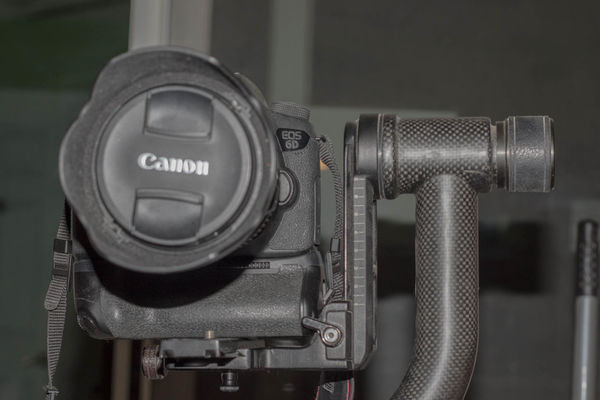
7DII over the arm
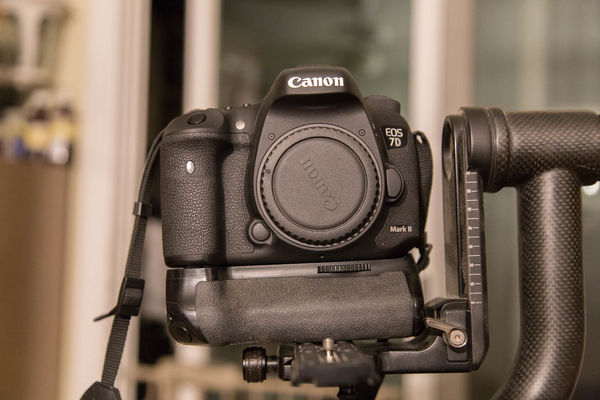
side view with camera in front of the arm
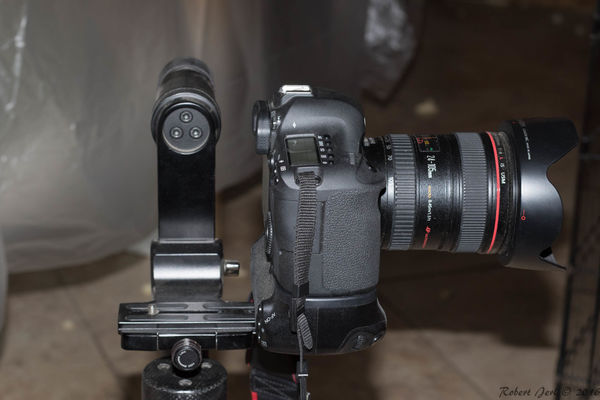
side view over the arm
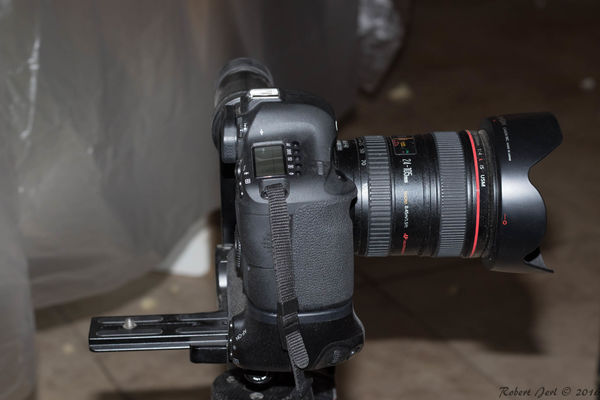
side view behind the arm
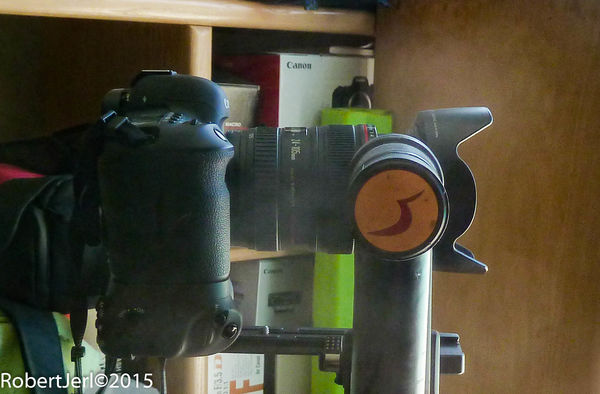
front view behind the arm
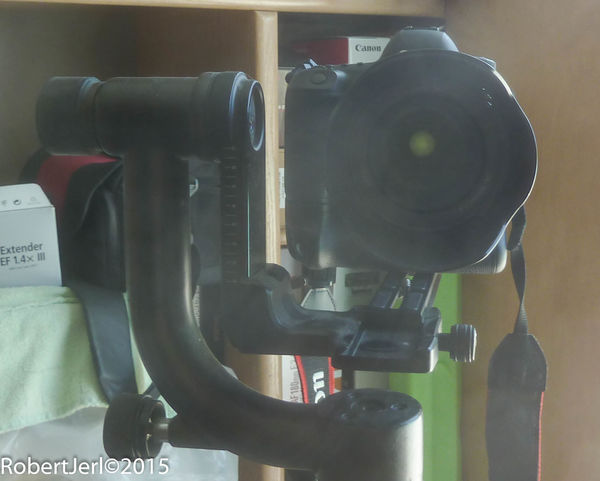
Nest QR plate 6+"
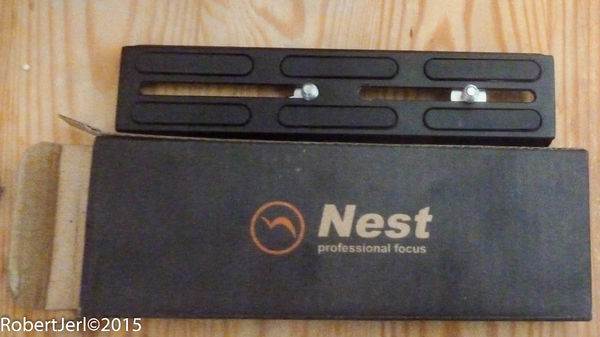
the usual use of a gimbal head
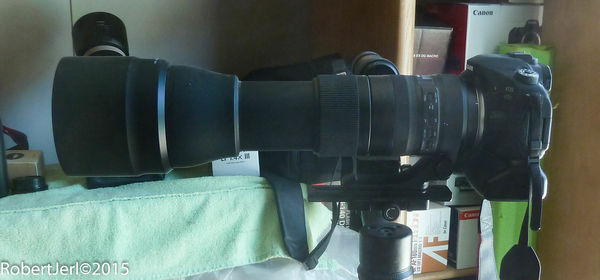
Aug 7, 2019 14:07:53 #
amfoto1 wrote:
There's no case I can think of where ANY L-plate w... (show quote)
There is no case you can think of using an L-plate on a gimbal??? It doesn't matter what head you mount your camera to, you'll never remove the L-plate (why, that would make no sense)! So the case would be: anytime you mount it to a gimbal head!
Aug 7, 2019 15:21:18 #
It must be a very slow day today. . . Or maybe the heat is getting to people.
Aug 7, 2019 15:45:57 #
Yeah, I just thought of one thing you can't do on the gimbal head with the body mounted instead of a long lens with tripod collar.
You can't rotate it for a portrait composition.
You can't rotate it for a portrait composition.
Aug 7, 2019 16:08:44 #
amfoto1
Loc: San Jose, Calif. USA
robertjerl wrote:
Yeah, I just thought of one thing you can't do on the gimbal head with the body mounted instead of a long lens with tripod collar.
You can't rotate it for a portrait composition.
You can't rotate it for a portrait composition.
I agree that your "long plate" solution will work.... Except that I use fitted quick release plates on my cameras, which I'd have to remove to use that technique.
I mentioned an alternative above, but wasn't sure who made it. I just looked it up and it's Wimberley M8 Module "Perpendicular Plate". That would work with my cameras, without having to remove the QR plates already installed on them. HOWEVER, I'd have the same problem as you're seeing.... Only horizontal orientation would be possible with that module (with "bottom mount" gimbal... or vertical-only, with the less common "side mount" heads).
I think I'll stick with my ballhead and Wimberley Sidekick combo... much easier to switch back and forth... Plus, no bulky, expensive L-bracket needed, since camera CAN be directly mounted in the Sidekick for vertical orientation.... Of course, horizontal orientation is provided by mounting it directly to the ballhead, with the Sidekick removed. All that can be done in a few seconds without need for any tools.
Aug 7, 2019 16:53:18 #
Thank you! Without the L plate in hand it is a bit difficult to figure it out.
Much appreciated!!!!
Much appreciated!!!!
Aug 8, 2019 05:57:34 #
Aug 8, 2019 07:53:54 #
I can suggest that you take a look at the-digital-picture.com website. He has a ton of reviews on equipment including ball heads, tripods and Wimberly and RRS gimbals. His review of the RRS P2 Pano Gimbal includes images showing why I consider this to be a system that can be used in more ways than one can think of or probably ever need. You can use all sorts of slides, feet, and L brackets to hold any DSLR style body and lens combination. I think his sight is worth looking at for gear reviews.
Any L bracket that that fits your camera and has Arca Swiss style dovetailed slots is probably compatible with the Nest Gimbal. I have an L bracket on my camera virtually 100 percent of the time. If I need to remove the L part it takes 20 seconds and about the same if I want to remove the entire 2 piece bracket. Different strokes for different folks.
Any L bracket that that fits your camera and has Arca Swiss style dovetailed slots is probably compatible with the Nest Gimbal. I have an L bracket on my camera virtually 100 percent of the time. If I need to remove the L part it takes 20 seconds and about the same if I want to remove the entire 2 piece bracket. Different strokes for different folks.
traveler90712 wrote:
Are there compatible "L" plates for the Nest gimbal?
Aug 8, 2019 08:33:46 #
mizzee
Loc: Boston,Ma
A comment on L brackets: you must check for compatibility. The “universal” ones may block battery doors or card doors. Even ones made for your camera may not work well. I bought an L for my Olympus, made for my camera and was dismayed to find that I wasn’t able to use my articulating screen.
Aug 8, 2019 08:48:46 #
A Wimberly gimbal lets you remove and invert the camera mounting plate to enable using short lenses. Not real convenient but it works in the field!
Aug 8, 2019 10:17:56 #
amfoto1 wrote:
There's no case I can think of where ANY L-plate w... (show quote)
If you have a side mount gimbal head then an L bracket allows you to use a shorter lens in landscape mode without having to change out the gimbal head.
Aug 8, 2019 13:27:43 #
amfoto1
Loc: San Jose, Calif. USA
OllieFCR wrote:
If you have a side mount gimbal head then an L bracket allows you to use a shorter lens in landscape mode without having to change out the gimbal head.
That's true... I stand corrected.
In fact, with a side-mount gimbal, the L-bracket would allow both landscape and portrait orientation of the camera with short lens (i.e., no tripod collar on the lens).
However, original poster was asking about the Nest, in particular. I believe that gimbal is only available in bottom-mount design and don't know that it can be converted to side-mount (the way some can).
There's a fairly comprehensive, illustrated list of available gimbals here: http://www.carolinawildphoto.com/gimbal_list.htm
What's not shown there is the Nest, I'm not sure why since it's pretty popular. But, like many of them, the Nest design is very similar to the Wimberley WH-200 (a mild update of the original Wimberley head from 1991, which was the first gimbal head for photographers). The Nest is carbon fiber, which saves a bit of weight and might absorb some fine vibrations as well. Most other gimbals are metal.
Aug 8, 2019 14:07:07 #
The Carolina wild photo page does talk about the Nest Gimbal but doesn’t list it is n the table. The author seems to have his opinions on what is best and why. That’s fine but I do think it might give people a less than full view of the capabilities of Pano Gimbal system like I consider the RRS P2. I owned the Wimberly II and it is a solid piece for sure and I resold it for very good money, but I am happy with the RRS P2 that replaced it.
amfoto1 wrote:
That's true... I stand corrected. br br In fact,... (show quote)
If you want to reply, then register here. Registration is free and your account is created instantly, so you can post right away.



